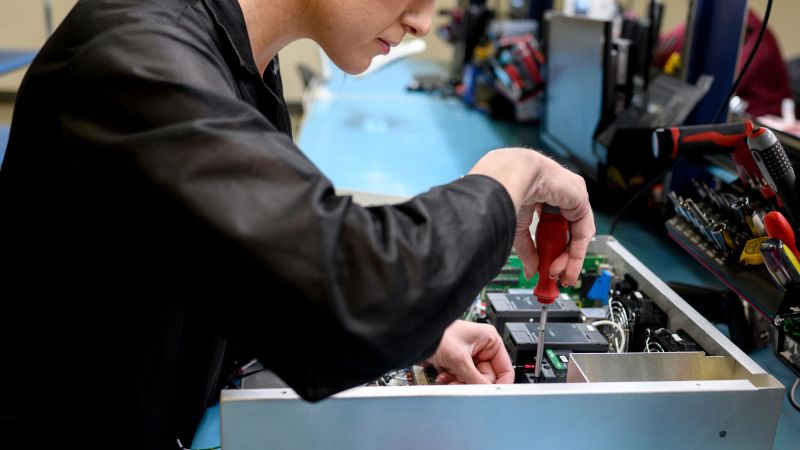Justin Merriman/Bloomberg/Getty Images
A worker assembles a product at the Intervala manufacturing facility in Mount Pleasant, Pennsylvania, US, on Tuesday, January 30, 2024.
Washington, DC
CNN
—
Americans are on the verge of living through a historic economic event: inflation fully returning to normal — after a series of punishing interest rate hikes — without a recession. It’s a scenario that analysts refer to as a “soft landing.”
The substantial progress seen so far may be due to a recent burst of productivity growth.
Last year’s strong US productivity meant that workers raked in strong wage gains without employers having to pass on the buck to consumers, at least to a large degree, since they were producing enough in various industries and services to cover for those higher labor costs.
In economics, the concept of productivity is essentially what the word itself means in everyday speak. If productivity is strong, that means the US economy is doing more with less, or being more productive. Since that was indeed the case last year, it meant that the economy was able to grow at the robust pace it did in 2023 without stoking inflation.
Productivity is measured by dividing all the goods and services produced in the economy by every hour people worked. That rate jumped 2.7% in the fourth quarter from a year earlier, according to Labor Department data, which was above the average increase over the past two decades. After falling sharply in 2022, productivity rebounded mightily the following year.
“Productivity is incredibly important for the broader economic and inflation picture, so the question of if workers are going to be more productive is an important one that central banks are considering,” Lauren Goodwin, economist and chief market strategist at New York Life Investments, told CNN.
There isn’t one definitive reason why productivity grew robustly last year.
One popular theory is that the proliferation of generative artificial intelligence may have made operations for certain tasks more efficient. Researchers argue that GenAI could be transformative in the world of finance and economics, and perhaps in society more broadly, akin to the widespread adoption of the internet around the turn of the century.
But larger productivity gains due to GenAI may take time to become a reality since workers need to be trained on how to utilize it first and firms have to figure out how to best integrate GenAI into their processes, Mark Zandi, Moody’s Analytics chief economist, told CNN previously.
Another possibility is that companies became more productive last year in anticipation of a recession that never happened, according to economists. The job market last year was robust, but some major companies still cut costs, including through layoffs. For example, Microsoft, Meta, 3M, and Citigroup cut thousands of jobs last year.
“A lot of those companies that laid people off because they were expecting a significant slowdown are now lean and mean,” John Min, chief economist at Monex USA, told CNN. “But the economy did well, so that translated into higher productivity, supporting higher wage growth and fending off inflation from accelerating.”
Last year’s productivity boom could also be a combination of all of the above.
It’s clear that Federal Reserve officials consider productivity before making policy decisions. Chicago Fed President Austan Goolsbee told Bloomberg in an interview last year that “you can’t say anything about wages until you actually know what’s happening with productivity.”
But the economic indicator is difficult to precisely measure in real time, which is why it rarely ever moves financial markets whenever it is released.
It’s also released quarterly, the data are usually subject to heavy revisions and it is tough to accurately measure the productivity of services.
“The US is mostly a services-based economy instead of manufacturing, so if I’m counting the number of widgets being produced per hour, then that can be pretty accurate, but on the service side, it’s really hard to know if the price of a haircut went up because of inflation or because it was a better haircut,” Min said.
With 2023 already in the rear-view mirror, productivity may have played a role in creating a path toward a soft landing.
Still, it may be too soon to know if last year’s productivity burst was truly a transformative shift in the US economy.
“Sometimes at the very end of an economic cycle, productivity can be boosted by cost-saving measures,” Goodwin of New York Life Investments said. “Distortions like reducing worker hours might come out as productivity being really high, but when you look at the broader picture, companies are reducing costs by giving people less hours, effectively paying them less, so it’s not that necessarily something is going a lot better for the economy.”
“However, my expectation is that we will see improvements in productivity as a result of generative tools, contributing to disinflation over a longer time period,” she said.
